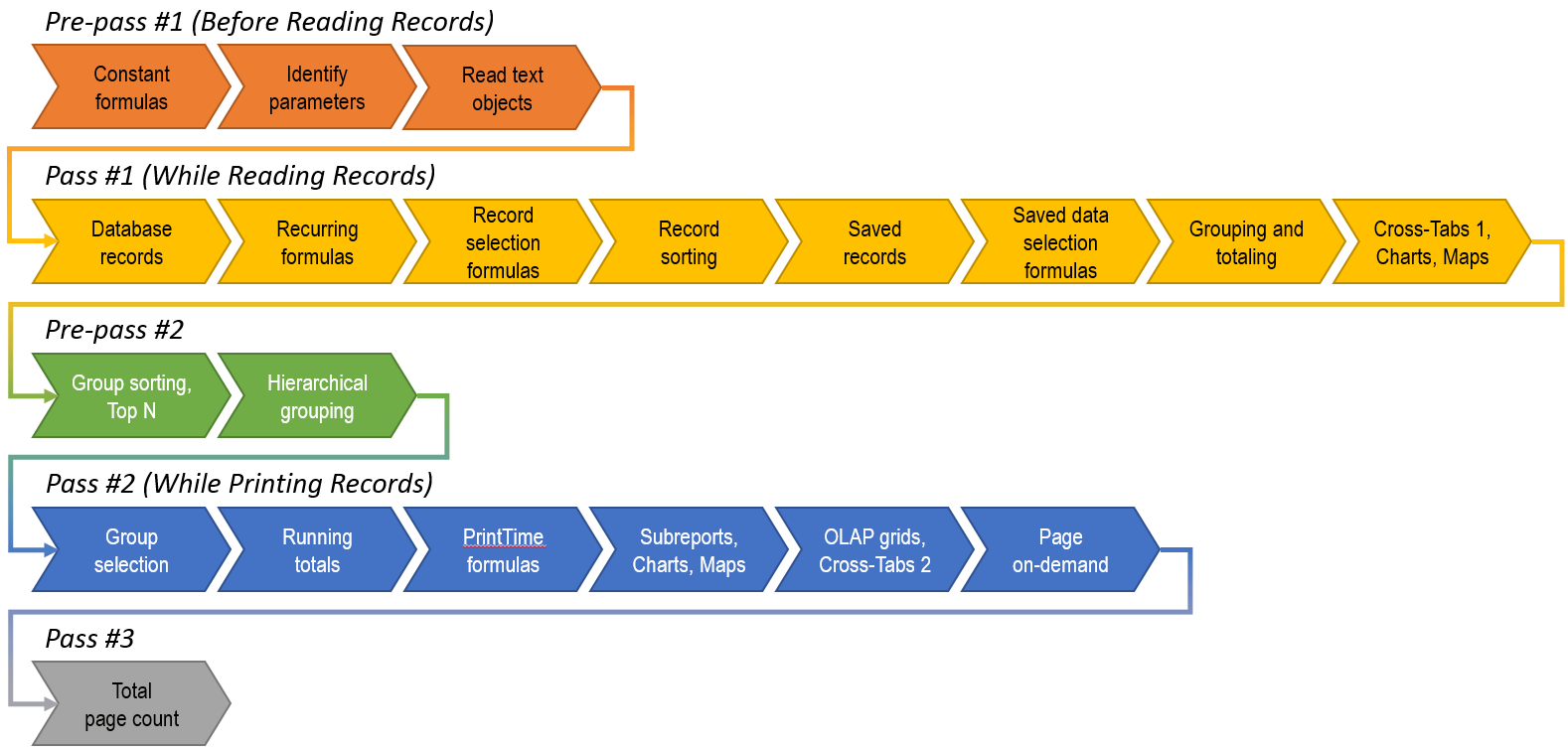Crystal Reports Multi-Pass Processing Engine
Business Objects, Crystal Reports
Crystal Reports uses a three-pass reporting method to generate reports. A pass is a process that Crystal Reports uses each time the data is read and manipulated. Depending on the complexity of the report Crystal Reports may make 1, 2, or 3 passes over the data. This feature allows for complex reporting and formula manipulation.
(Click the image above for high-resolution version)
Pre-Pass #1
When previewing a report, the first elements to be evaluated are “constant” formulas. Constant formulas are those that have a constant value for the entire report. They do not change from record to record. For example, 100* 30 would be a constant formula. Constant formulas are evaluated at the beginning of the print generation process and are never evaluated again. This process is known as “BeforeReadingRecords.” If you were to place a constant formula field (i.e., 100*30) in the Details section, the result would be 3000 for each record displayed.
Crystal Reports also identifies any parameters contained in the report and reads all of the text objects.
Pass #1
After the “BeforeReadingRecords” process has taken place, Crystal Reports begins reading the database records. During the record reading process, the following will occur:
- Record retrieval
Where possible record selection and sorting are pushed down to the database in this step. Evaluation of recurring formulas. These formulas are those that contain database fields but do not contain references to subtotals or summary information. This evaluation time is known as “WhileReadingRecords.” Formulas that contain references to subtotals or summary information are processed in the second pass. - Application of the record selection locally
If the record selection is too complex to be pushed down to the database, it is applied by Crystal Reports in this step. - Application of the saved data record selection formulas
When records return to the report, they are further filtered through any existing saved data formulas. - Sorting, grouping, and totaling
In this step, Crystal Reports sorts the records, separates them into groups, and then calculates the subtotals and summaries needed for each group. - Cross-Tab, chart, and map generation
Only Cross-Tabs, charts, and maps that are based entirely on database fields and recurring formulas are generated in Pass 1. If these objects include running totals and/or PrintTime formulas, they are generated in Pass 2. - Storage of saved data
After the totaling process is complete, all of the records and totals are stored in memory and to temporary files. Crystal Reports does not read the database again, but instead uses this saved data during all subsequent processing.
Pre-Pass #2
During Pre-Pass 2, Crystal Reports orders the groups in the report for Top/Bottom N or Hierarchical Grouping. The records are not read in this process, instead Crystal Reports only looks at group instances from Pass 1, and takes the Top N as appropriate, or orders the groups based on the Hierarchical Grouping settings specified.
Pass #2
Crystal Reports enters the second pass through the data to format pages. The pages are formatted on demand. This means that Crystal Reports will not format a page until it is requested by the user, or until it is required for the total page count in Pass 3.
During page formatting, Crystal Reports does the following:
- Group selection formulas.
- Running totals.
- Calculation of formulas marked “WhilePrinting Records.” These are formulas that contain references to subtotals or summary information, also known as “PrintTime” formulas. This evaluation time is known as “WhilePrinting Records.”
- Cross-Tabs, charts, and maps.
- Cross-Tabs, charts, and maps that include running totals and/or PrintTime formulas, and charts that are based on Cross-Tabs are generated in Pass 2.
- OLAP grids.
- Subreports
- Generation of Pages on Demand.
You can use on-demand subreports to ensure that your main report remains a single-pass report. With on-demand subreports, Crystal Reports must still make a second pass through the data; however, this second pass does not begin until you drill down on the subreport. Consequently, you can increase the performance of reports that contain subreports by using on-demand subreports.
Caution
Subtotals, grand totals, and summaries might appear incorrectly if the report has a group selection formula. This occurs because the grand totals and summaries are calculated during Pass 1, but the group selection formula filters the data again in Pass 2. Running total fields or Formula fields with variables can be used instead of summaries to total data successfully with group selection formulas.
Pass #3
In the third and final pass, the total page count is determined. This applies to reports that use the total page count, or Page N of M special fields.
Conclusion
Understanding the multi-pass reporting paths of the Crystal Reports engine helps in the general development and debugging of your production reports. Additional leveraging of the built-in Formula functions discussed previously (BeforeReadingRecords, WhileReadingRecords, and WhilePrintingRecords) in combination with the EvaluateAfter() function enable you to design more flexible reports and formulas. These functions also enable you to leverage advanced variable usage and successful sharing among subreports.
